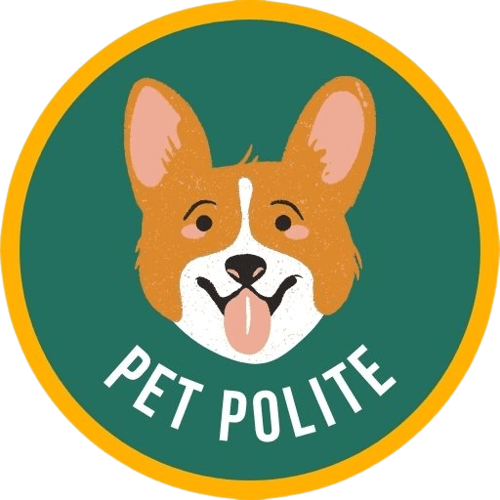Are you making critical mistakes in grooming your German Shepherd? From coat care to nail trimming, they require a regular grooming routine to maintain their optimal health.
But do you know there are some grooming mistakes that can cause serious damage to their coat health?
Grooming mistakes for German Shepherds include infrequent brushing, improper grooming tools and products, neglecting dental and ear care, skipping nail trimming, and shaving their double coats. Additionally, some incorrect grooming techniques can also lead to coat and skin issues in your German Shepherd.
In this article, we’ll explore 6 German Shepherd grooming mistakes in detail, shedding light on why they matter, how they can impact your beloved pet, and practical strategies to overcome them.
Let’s start discussing the common German Shepherd grooming mistakes!
Contents
- 1 Mistake 1: Neglecting Regular Brushing
- 2 Mistake 2: Bathing Too Much
- 3 Mistake 3: Using Incorrect Grooming Tools And Products
- 4 Mistake 4: Overlooking Ear and Dental Care
- 5 Mistake 5: Ignoring Nail Maintenance
- 6 Mistake 6: Shaving Your German Shepherd’s Coat
- 7 What Are Common Mistakes Professional Groomers Can Make?
- 8 How Can You Respond When Discovering Negligence Or Mistakes By Groomer?
- 9 Conclusion:
- 10 Frequently Asked Questions:
Mistake 1: Neglecting Regular Brushing
While brushing is a cornerstone of maintaining a healthy coat in German Shepherds, neglecting this essential grooming practice can lead to serious skin and fur issues.
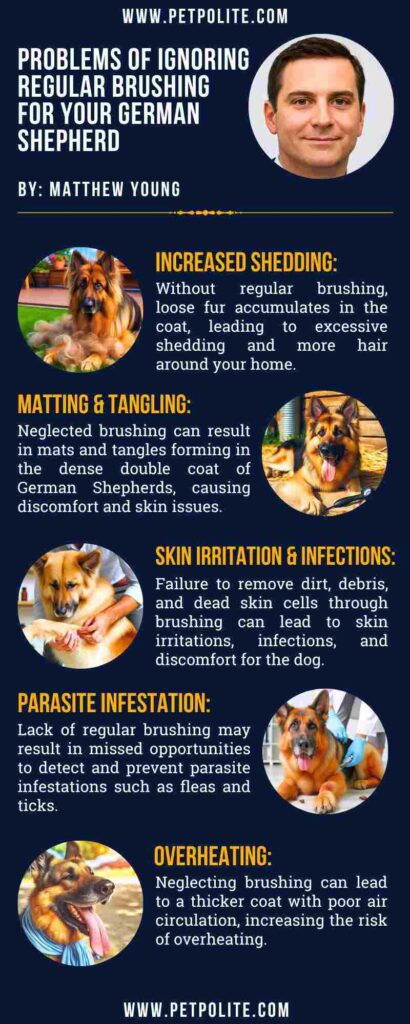
Why brushing is important for your German Shepherd:
Here’s why brushing your German Shepherd is a must-do, not a maybe-later:
- Reduces Shedding:
- Prevents Mats and Tangles:
- Distributes Natural Oils:
- Boosts Bonding Time:
- Early Detection of Issues:
But, if you neglect to brush their coat, it can become tangled and matted, which not only looks unsightly but can also cause skin irritation and even infections.
Additionally, neglecting to brush your German Shepherd can cause the buildup of dirt, debris, and excess hair, which may contribute to shedding and a less hygienic environment for you and your pet.
Overall, neglecting to brush your German Shepherd can compromise the overall quality of their life.
How to brush your German Shepherd?
Aim to brush your German Shepherd’s coat at least 3-4 times a week, focusing on areas prone to matting and shedding, such as behind the ears and under the collar.
Use a high-quality slicker brush, pin brush, or undercoat rake specifically designed for your German Shepherd to remove loose fur and prevent mats from forming.
You’ll be rewarded with a healthy, happy dog and a fur-free home (well, mostly fur-free!).
Mistake 2: Bathing Too Much
You might think that giving your furry friend frequent baths will keep them smelling fresh, but in reality, it can do more harm than good.
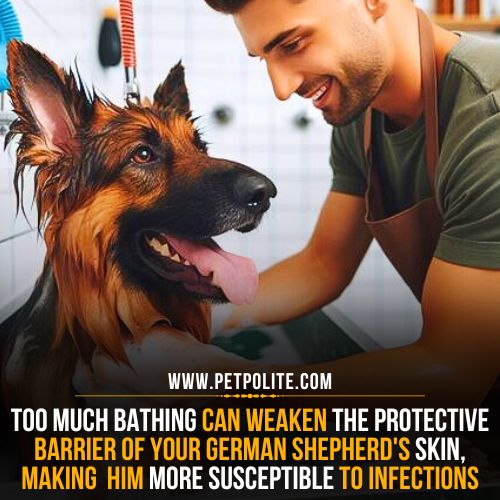
Risks of Over-Bathing:
These are some potential risks your German Shepherd can face if you bathe him too frequently.
- Overbathing removes natural oils, leading to dryness and irritation.
- Excessive baths disrupt skin pH balance, increasing infection risk.
- Too much washing weakens the skin’s defenses against allergens.
- Stripping their coat’s waterproofing oil leaves them vulnerable to external elements.
- Disrupting the natural balance of bacteria on their skin can lead to skin problems.
By learning how often to bathe your German Shepherd, you can keep him clean and comfortable without overdoing it.
How often should you bathe your German Shepherd?
The frequency of bathing your German Shepherd depends on several factors, including their activity level, environment, and individual skin and coat needs.
Generally, bathing your German Shepherd every 6-8 weeks is sufficient to keep them clean and maintain their coat’s health.
However, if they get dirty or develop a noticeable odor, you may need to bathe them more frequently.
Regular brushing between baths can also help remove loose fur, dirt, and debris, keeping your German Shepherd’s coat in good condition without the need for frequent bathing.
Mistake 3: Using Incorrect Grooming Tools And Products
Your German Shepherd’s sensitive skin can easily become irritated if you use harsh chemicals and abrasive grooming tools.
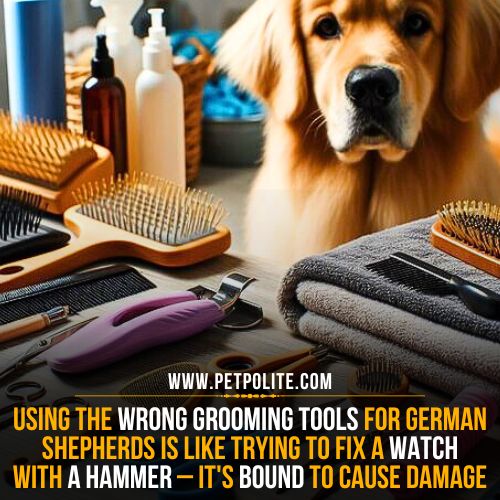
The Wrong Tools for the Job:
You might be tempted to use any grooming tools you have lying around the house, but when it comes to German Shepherds, one size doesn’t fit all.

Dogs come with coats of different lengths and thicknesses, so brushes and grooming tools aren’t a one-size-fits-all thing.
Source: Lucky Dawg Salon Grooming
Avoid using fine-toothed combs, which can get stuck in their thick double coat, causing frustration for you and your pup.
These are some grooming tools you should avoid:
- Generic Brushes
- Harsh Combs
- Low-Quality Scissors
- Human Hair Clippers
- Shampoos Not Meant for Dogs
Instead, you can choose gentle, hypoallergenic options specifically formulated for German Shepherds.
The Right Tools for A Healthy German Shepherd Coat:
If you invest in the proper grooming tools and products for your German Shepherd, it will make all the difference in your mission to keep their coat in top condition.
These are some of the grooming tools you can use for your German Shepherd:
- Slicker Brush
- Undercoat Rake
- Pin Brush
- Stainless Steel Comb
- Nail Clippers or Grinder
- Ear Cleaner and Cotton Pads
- Dog-Specific Shampoo and Conditioner
- Toothbrush and Toothpaste
Using these grooming tools and products will help your German Shepherd minimize shedding, reduce the risk of matting, and prevent skin irritation.
Mistake 4: Overlooking Ear and Dental Care
Just like humans, German Shepherds also require regular ear and dental care to maintain their optimal health.
Neglecting these areas can lead to a range of issues, including ear infections, dental diseases, and discomfort for your pet.
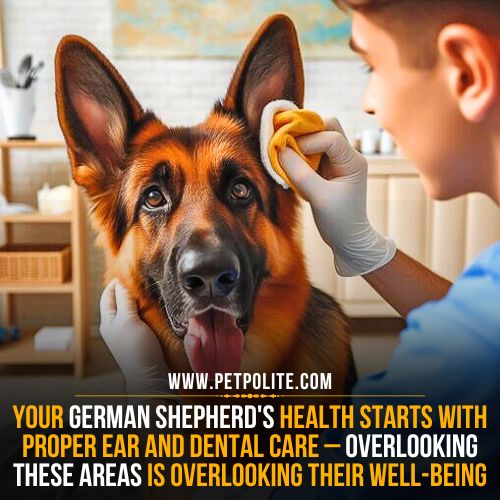

Common Mistakes in Ear and Dental Care:
Unfortunately, many German Shepherd owners overlook the importance of ear and dental hygiene, which puts their dog’s health at risk.
If you do not clean your dog’s ears it can allow wax and debris to build up, creating the perfect environment for bacteria and yeast to thrive.
Similarly, skipping dental hygiene can result in plaque and tartar buildup, leading to gum disease, tooth decay, and bad breath.
Tips for Proper Ear Cleaning and Dental Care:
To avoid the pitfalls of neglecting ear and dental care, it’s essential to establish a regular grooming routine for your German Shepherd.
When cleaning your dog’s ears, use a gentle ear cleaner specifically formulated for pets and avoid inserting anything into the ear canal.
Instead, gently wipe the outer ear with a cotton ball or pad to remove dirt and wax buildup.
For dental care, brush your German Shepherd’s teeth regularly using a soft-bristled toothbrush and pet-safe toothpaste.
Aim to brush their teeth at least a few times a week, focusing on the outer surfaces and gumline.
Additionally, provide dental chews or toys designed to promote oral health and prevent tartar buildup.
Mistake 5: Ignoring Nail Maintenance
Just like us, dogs’ nails grow continuously and need regular trimming. Neglecting this can lead to significant joint and posture-related issues.
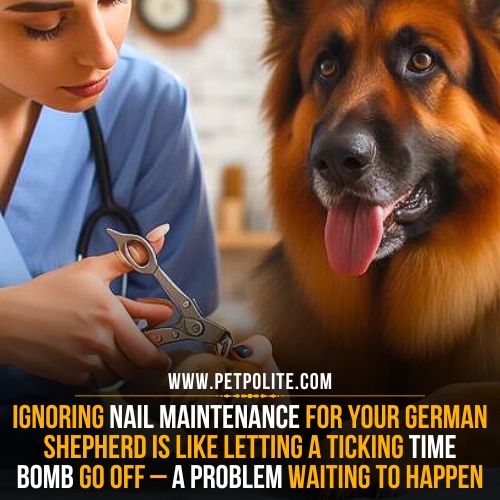

Risks of Overgrown German Shepherd Nails:
Ignoring nail maintenance can cause several risks for your German Shepherd, including nail breakage, difficulty walking, and even injury.
Overgrown nails are more prone to splitting or breaking, which can be painful and may result in bleeding or infection.
Additionally, long nails can cause your dog to walk on their toes, leading to discomfort and potentially affecting their joints and posture.
How to Trim Overgrown German Shepherd’s Nails?
To ensure your German Shepherd’s nails stay at a healthy length, it’s essential to cut their nails every 2-3 weeks.
Use a pair of high-quality nail clippers specifically designed for dogs, as human clippers can crush or splinter the nail.
Start by trimming small amounts of the nail at a time, avoiding the quick – the sensitive blood vessel inside the nail.




“If you trim your dog’s nails without experience, you might accidentally cut into the blood supply, called the quick. This can cause your dog’s nail to bleed a lot.“
Source: BARK.CO
Aim to trim approximately 2-3 mm away from the quick to prevent discomfort or bleeding.
If you’re unsure about how to trim your dog’s nails safely, consider seeking guidance from a professional groomer or veterinarian.
Here’s a video guide on how you can clip your German Shepehrd’s nails:
Mistake 6: Shaving Your German Shepherd’s Coat
Shaving your German Shepherd is generally not recommended.
Their double coat serves important functions, such as regulating body temperature and repelling dirt and pests.


Shaving can disrupt these natural protections and lead to issues like sunburn, skin irritations, and uneven hair growth.
What Happens If I Shave My German Shepherd?
Shaving your German Shepherd can have several negative consequences.
Removing their double coat, which serves as insulation against heat and cold, can leave them vulnerable to temperature extremes.
This can result in sunburn during hot weather and an increased risk of hypothermia in colder climates.
Shaving also disrupts the coat’s natural ability to repel dirt and pests, making your dog more susceptible to skin irritations and infestations.
Additionally, shaving can lead to irregular hair growth, patchiness, and skin problems as the coat regrows.




“Shaving a double coat too short can lead to uneven regrowth, with the inner layer of fur growing back slower and thinner than the outer layer. This can result in bald spots.“
Source: QC Pet Studies
What Can You Do Instead of Shaving Your German Shepherd?
Instead of shaving your German Shepherd, opt for regular brushing to remove loose hair and prevent matting.
Consider professional grooming sessions for trimming and maintaining their coat.
Ensure your dog stays hydrated and provide shade in hot weather to help regulate their body temperature naturally.
These are some additional alternative options that you can use instead of shaving:
| Alternative Options | Action |
|---|---|
| Regular Brushing | Brush regularly to remove loose fur, dirt, and debris. |
| Proper Nutrition | Provide a balanced diet for a healthy coat. |
| Bathing with Gentle Shampoo | Use mild, dog-specific shampoo when necessary. |
| Use Conditioners or Coat Sprays | Apply moisturizing products designed for dogs. |
| Professional Grooming | Visit a groomer for trimming and de-shedding. |
| Environmental Control | Maintain proper indoor humidity levels. |
| Regular Exercise | Promote circulation for a healthier coat. |
What Are Common Mistakes Professional Groomers Can Make?
Although professional groomers have extensive experience in handling different dog breeds, it’s important to remember that even the most seasoned groomer can have an off day.
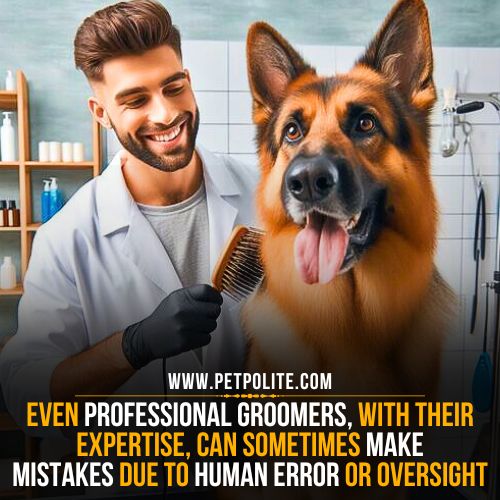

Here are some mistakes professional groomers make that you, as a pet parent, should be aware of:
- Leaving foreign objects, such as cotton balls or grooming tools, inside a pet’s ear or coat.
- Accidental cuts or injuries caused by sharp grooming tools or careless handling.
- Failure to properly restrain or handle pets, leading to escape or injury.
- Using improper grooming techniques or products.
- Neglecting to address specific grooming requests or medical concerns provided by pet owners.
By being aware of these potential mistakes, you can become a more informed pet parent and advocate for your furry friend’s well-being.
How Can You Respond When Discovering Negligence Or Mistakes By Groomer?
If you discover negligence or mistakes by groomers, it’s important to address the situation calmly and professionally.
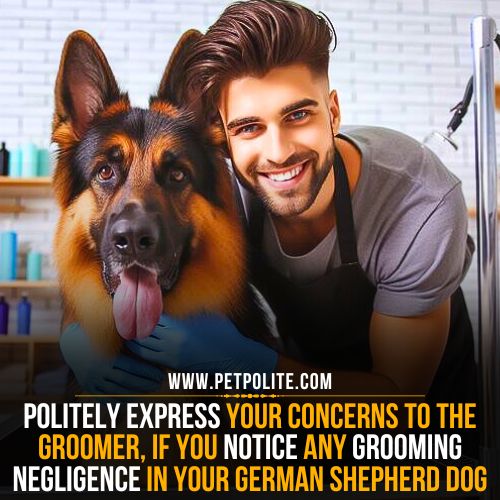

Firstly, express your concerns directly to the groomer or the grooming salon manager, and provide them specific details about the issue like photographs or written records.
Politely inquire about their policies for addressing such situations and seek a resolution.
However, if you feel your concerns are not addressed properly, you have the right to voice your dissatisfaction through online reviews and consumer feedback platforms.
It’s crucial to prioritize the safety and well-being of your pets and take proactive measures to prevent similar incidents in the future.
Conclusion:
In conclusion, avoiding grooming mistakes for German Shepherds is essential to maintain their health and well-being.
Neglecting proper grooming, such as infrequent brushing, using incorrect tools, and skipping dental care, can lead to various issues like matting, discomfort, and oral health problems.
It’s crucial to prioritize regular grooming routines, including brushing, nail trimming, and ear and dental care, to ensure your German Shepherd stays happy and healthy.
With proper care and attention to detail, you can help your German Shepherd look and feel their best for years to come.
Frequently Asked Questions:
Can A German Shepherd be shaved?
While it’s physically possible to shave a German Shepherd, it’s generally not recommended. Shaving their double coat can disrupt its natural insulation and protection, leading to potential health issues like sunburn and overheating.
How do I fix a German Shepherd’s coat after I accidentally shaved it?
Ensure your dog receives a balanced diet for coat health. Regularly brush the coat to stimulate skin and distribute oils. Use gentle, moisturizing products to hydrate the skin and promote hair growth.
How often should I groom my German Shepherd?
German Shepherds typically require grooming every 4 to 8 weeks. However, the frequency may vary based on factors like coat length, activity level, and individual grooming needs. Regular brushing at home is also essential for coat maintenance.
Will my German Shepherd’s hair grow back?
Yes, German Shepherds’ hair will grow back after being trimmed or shaved. However, it may take some time for the coat to fully regrow, and the new growth may have a slightly different texture or appearance initially.
Will shaving a German Shepherd dog mess up his coat?
Shaving a German Shepherd’s coat can disrupt its natural insulation and protection, potentially leading to issues like sunburn and overheating. It’s generally not recommended as it may negatively affect the coat’s texture and regrowth.
Resources Used For Research:
- Dog Owners’ Ideas and Strategies Regarding Dental Health in Their Dogs-Thematic Analysis of Free Text Survey Responses – National Library of Medicine
- German Shepherds: A Practical Guide for Owners and Breeders – A Book by Allison Clarke and Lizzy Brown
- Barriers to and facilitators of pet grooming among clients served by a subsidized grooming service program – National Library of Medicine
- Grooming Dogs: What’s Good and Bad From Their Point of View – Psychology Today
